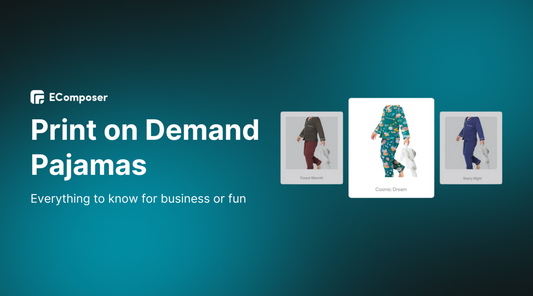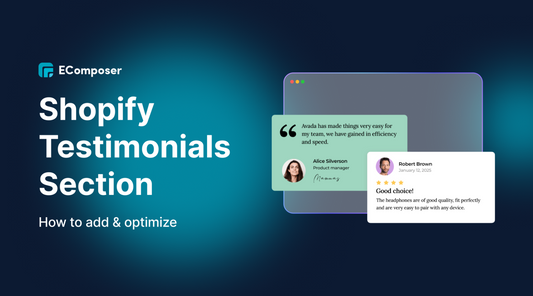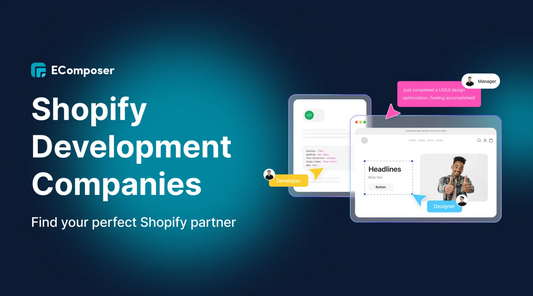️🏆 Which Attributes Describe a good Landing Page Experience?

Table Of Contents
In today's digital landscape, where attention spans are fleeting and competition is fierce, a captivating landing page holds the key to unlocking remarkable results. It serves as the virtual doorway to your brand, enticing visitors and driving them towards meaningful actions. But which attributes describe a good landing page experience?
In this blog, we will explore the essential attributes that make a landing page truly effective. Stay tuned as we unpack the keys to a high-converting landing page as well as the best practices to design the page.
What is a good landing page experience?

(image source: EComposer’s landing page template)
A good landing page experience is essentially the successful blend of design, content, and functionality that meets the user's needs, achieves your business objectives, and ultimately drives conversions.
It is a carefully orchestrated online destination where every element, from the copy to visuals and layout, works cohesively to guide visitors towards the desired action, whether it's making a purchase, subscribing to a newsletter, or any other goal. Moreover, it's about creating an intuitive and satisfying user journey, instilling trust, and effectively communicating your brand's value proposition.
The Importance of a good landing page experience

A good landing page experience is crucial for the success of any online business or marketing campaign. It refers to the overall user experience someone has when they visit a specific landing page on a website or platform. The importance of a good landing page experience can be understood from the following aspects:
First Impression
A landing page is often the first interaction a visitor has with your brand or offer. It needs to make a positive and memorable impression to capture their attention and encourage them to explore further. A well-designed and visually appealing landing page creates a positive first impression, increasing the chances of conversion.
User Engagement
A good landing page experience focuses on engaging users and keeping them interested in your content or offer. The page should provide relevant and valuable information that aligns with the visitor's expectations. By offering clear and concise messaging, compelling visuals, and easy-to-understand navigation, you can enhance user engagement and encourage them to take desired actions.
Conversion Rate Optimization
The ultimate goal of a landing page is to convert visitors into customers or leads. A good landing page experience optimizes the conversion rate by guiding users towards a specific goal, such as making a purchase, filling out a form, or subscribing to a newsletter. Elements like persuasive copywriting, prominent call-to-action buttons, and trust signals (such as testimonials or security badges) are vital in convincing visitors to take action.
Improve Ad Performance
Landing pages are often associated with paid advertising campaigns. When users click on an ad and arrive at a landing page that delivers a consistent and relevant experience, they are more likely to stay engaged and convert. This improves the overall performance of your advertising efforts, leading to higher click-through rates (CTR), lower bounce rates, and improved return on investment (ROI).
Positive Brand Perception
A well-crafted landing page contributes to positive brand perception. It reflects professionalism, credibility, and attention to detail, which are vital for building trust with your target audience. A positive experience on the landing page can lead to increased brand loyalty, word-of-mouth referrals, and repeat business.
In conclusion, a good landing page experience is essential for attracting, engaging, and converting website visitors. It sets the foundation for successful marketing campaigns, helps build brand credibility, and ultimately contributes to the growth and success of your online business.
What makes a good landing page experience + best practices
Creating a stellar landing page experience involves a multitude of factors, each contributing to the overall user experience and influencing conversion rates. Here's a deep dive into the key attributes that define a good landing page experience and their best practices:
Relevant and unique content

Relevant and unique content refers to the original and substantial information that directly addresses the needs and interests of your target audience. This content should offer value, be distinctive from what your competitors are offering, and be directly related to your headline or marketing campaign.
This attribute increases the likelihood that visitors will stay on your page and take the desired action. It also helps to improve your search engine ranking, making your page more discoverable. According to HubSpot, 47% of buyers view at least 3-5 pieces of content before deciding to speak with a sales rep, indicating the importance of relevant content in conversion.
Best Practices
- Know Your Audience: Understanding your audience is the first step towards creating relevant content. Identify their needs, preferences, and pain points, and tailor your content to address these.
- Use Clear and Compelling Headlines: Your headlines should immediately convey what you're offering and why it's beneficial. A good headline grabs attention and encourages visitors to stay on your page.
- Maintain Content Freshness: Regularly update your content to keep it current and relevant. This could involve updating statistics, incorporating new trends or information, or simply refreshing the copy.
- Highlight benefits, not product features: Instead of simply enumerating the characteristics of the product, it is important to emphasize how these attributes contribute to enhancing the user's experience.
- Use Testimonials and Reviews: These provide social proof and add credibility to your claims, making your content more persuasive.
- Include Strong Calls to Action: These guide your visitors on what to do next, whether that's subscribing to a newsletter, making a purchase, or downloading an e-book.
By focusing on creating relevant and unique content, you can enhance your landing page experience, increase engagement, and boost conversions.
User-friendly navigation

User-friendly navigation refers to the ease users can move around your landing page and locate the information they need. It includes elements like menus, buttons, links, and scrolling functionality that guide visitors through your page content.
Good navigation enhances the user experience by reducing confusion and frustration. When visitors can find what they're looking for quickly and easily, they're more likely to stay on your page and take the desired action. According to a study by HubSpot, 76% of consumers say the most important factor in a website's design is the ease of use, highlighting the importance of user-friendly navigation.
Best Practices
- Keep It Simple: Avoid complex menus and unnecessary links that can confuse visitors. Stick to clear, concise, and predictable navigation structures.
- Clear and Concise Menu: Design a clear and concise menu that prominently displays the main sections or categories of your website. Use familiar labels that accurately represent the content within each section.
- Logical Information Hierarchy: Organize your content in a logical hierarchy, starting with broad categories and gradually drilling down into more specific subcategories. This helps users understand the relationship between different pages and easily navigate through them.
- Intuitive Navigation Placement: Place your navigation menu in a prominent location, typically at the top of the page or in the sidebar. Users expect to find navigation in these areas, and it facilitates easy access to different parts of your website.
- Responsive Design: Ensure that your landing page is responsive and adapts well to different screen sizes and devices. Mobile-friendly navigation is crucial since a significant portion of internet users browse websites on smartphones and tablets.
- Minimize Clutter: Avoid overwhelming visitors with too many options or links. Keep the navigation menu clean and clutter-free by including only essential categories and links. Consider using drop-down menus or collapsible sections for additional content.
- Consistent Navigation Across Pages: Maintain consistency in navigation elements throughout your website. Visitors should be able to rely on consistent placement, style, and functionality of the navigation menu as they move from one page to another.
- Visual Cues and Feedback: Provide visual cues to indicate the active page or section in the navigation menu. Highlight the current page or use breadcrumb navigation to show users their location within the website's structure. Additionally, provide clear feedback when users interact with navigation elements, such as button clicks or menu expansions. Arrows, buttons, or images can guide users towards essential sections of your page.
- Search Functionality: Include a search bar prominently on your landing page to allow users to quickly find specific content. Implement an intelligent search algorithm that provides relevant results even for partial queries or misspellings.
By implementing these best practices, you can create a user-friendly navigation system that enhances the landing page experience, improves user satisfaction, and increases conversions. Remember to iterate and refine your navigation based on user feedback and evolving trends to ensure it remains effective over time.
Transparency and Trustworthiness

Transparency and trustworthiness refer to how open, honest, and reliable your landing page appears to your visitors. It includes displaying clear information about your product/service, having a straightforward privacy policy, including security badges, and showcasing customer reviews and testimonials.
Trust is a fundamental factor in the decision-making process of customers. If visitors don't trust your site, they're unlikely to convert, regardless of how great your product or service might be. According to a study by Statista (2022), 60% of consumers shared that trustworthiness and transparency are the most essential factors for a brand.
Best Practices
- Showcase Testimonials and Reviews: Real reviews and testimonials from past customers provide social proof and build trust.
- Clear and Honest Messaging: Be transparent about what your product/service does, how much it costs, and what the user can expect.
- Security Badges: If you're asking for personal information, including security badges can increase trust by showing that their data will be safe.
- Privacy Policy: Make your privacy policy easily accessible and understandable.
- Contact Information: Include clear and visible contact information so users know they can reach you if they need to.
- Imagery and Design: Professional and aesthetically pleasing design can boost credibility and trust in your brand.
By prioritizing transparency and trustworthiness in your landing page design, you can build trust with your visitors, leading to higher conversion rates and a better overall user experience.
Fast Loading Time

Fast loading time refers to the speed at which your landing page loads when a visitor arrives. It includes the time it takes for all the elements on the page - images, text, videos, and more - to fully display.
In the era of digitalization, loading speed is crucial. A delay in page load time can lead to a significant decrease in engagement, page views, and customer satisfaction.
Based on research conducted by Google, over half of mobile website visits result in abandonment if page load times exceed 3 seconds.
What is the good page loading time?
Based on research conducted by Portent in 2019, the optimum load time for a webpage to achieve maximum conversion rates is between 0 to 4 seconds. It's during these initial five seconds that the webpage's loading speed has the most significant impact on conversion rates.
ECommerce sites witness their peak conversion rates on pages that load within a brisk 0 to 2 seconds. Any additional delay in the load time results in an average reduction in website conversion rates by about 4.42% per second.
Best Practices
- Efficient Code: Writing clean, optimized code helps reduce the loading time of websites and applications. Minifying CSS and JavaScript files, removing unnecessary whitespace and comments, and avoiding excessive use of third-party libraries can significantly improve loading speed.
- Image & videos Optimization: Visual materials often account for a significant portion of a webpage's file size. Optimizing images by reducing their dimensions, compressing them without losing visual quality, and using modern image formats can significantly improve loading times.
- Browser Caching: Implementing caching mechanisms allows web browsers and servers to store static resources locally. This way, subsequent visits to the website or application can load these resources from the cache instead of downloading them again, resulting in faster load times.
- Content Delivery Network (CDN): A CDN is a network of geographically distributed servers that deliver content to users based on their location. By hosting website assets on multiple servers across different locations, CDNs reduce the physical distance between users and the server, thereby improving loading times.
- Server-Side Optimization: Optimizing server configurations, database queries, and code execution can have a significant impact on loading times. Techniques like database indexing, query optimization, and implementing efficient server-side scripts can help reduce server response times.
- Mobile Optimization: With the increasing use of mobile devices, optimizing for mobile loading speed is crucial. This includes techniques such as responsive design, adaptive image loading, and minimizing the number of HTTP requests.
- Continuous Performance Monitoring: Regularly monitoring and analyzing website or application performance using tools like Google PageSpeed Insights or Lighthouse can help identify bottlenecks and areas for improvement. By addressing these issues, developers can continuously optimize loading times.
It's important to note that achieving fast loading times is an ongoing process, and it requires a combination of various techniques depending on the specific context and requirements of the website or application.
Mobile Responsiveness

Mobile responsiveness refers to the ability of your landing page to adjust its layout, images, and functionalities to match the device on which it's being viewed, be it a desktop, tablet, or mobile device.
With the increasing prevalence of mobile browsing, having a mobile-responsive landing page is not just important, it's essential. According to Statista, as of the first quarter of 2023, mobile devices accounted for 58.33% of all website traffic globally. Thus, a page that's not optimized for mobile viewing can lead to a poor user experience and a high bounce rate.
Best Practices
- Responsive Design: Design your landing page with a variety of devices in mind. It should be easy to navigate and consume on both a large desktop screen and a smaller mobile screen.
- Touch-friendly interactions: Ensure all your buttons, forms, and menus are easy to use on a touchscreen. This means they should be large enough to tap and spaced far enough apart to avoid accidental clicks on the wrong item.
- Optimize Images: Ensure your images are not only properly sized for a mobile screen but also optimized to load quickly without consuming too much data.
- Condense Your Content: Mobile screens have less space, so it's important to present your content concisely. Break up long paragraphs, use bullet points, and utilize collapsible sections to make your content easy to consume on a smaller screen.
- Test on Multiple Devices: Use a variety of real devices as well as emulators to test the responsiveness of your landing page.
A mobile-responsive landing page not only enhances the user experience for a growing segment of your audience but can also have positive effects on your SEO ranking, as Google places importance on mobile optimization.
How to create a landing page for good experience
If you want to create a high-converting landing page which can respond to all the factors above, sign up for a Shopify account (only start with $1/month) and then install EComposer Landing Page Builder. This app can help you build stunning pages with ease. You just need to choose the premade layout and then customize it in your way.

EComposer is a Top-notch Shopify Page Builder designed to streamline your eCommerce store's design process. This robust tool is renowned for its intuitive drag-and-drop interface, empowering you to create stunning web pages without any coding expertise. Its standout features include a versatile range of customizable templates, efficient tools for creating mobile-responsive designs, and advanced SEO settings for improved visibility.
Whether you're creating product pages or crafting compelling homepages, EComposer's adaptability and ease of use make it an invaluable tool for any Shopify store owner looking to create a visually captivating and highly functional online store.
Learn how to make a landing page for better conversion here: How to design a Must-click in Shopify
Final thoughts
In conclusion, a good landing page experience is pivotal to the success of any online marketing initiative. The key attributes above aren't mere suggestions, but necessary components for designing a high-performing landing page.
But remember, continual testing and optimization are parts of the journey. What worked today might not work tomorrow, so it's crucial to keep an eye on performance metrics and adjust your strategy as necessary. Embrace the dynamic nature of the digital landscape and strive to provide the best possible landing page experience for your potential customers. It's time to leverage these insights and transform your landing page from just good to truly exceptional.
Others also read
Facebook Ads Landing Pages that Drive Impressive Conversions: Creation Guide & Tips
Best Landing Pages for Affiliate Marketing: Guide + Examples
Optimize SEO for Landing Page: 10 Proven Tips & Step by Step Guide
Successful Landing Page Copywriting: 8 Must-have Tips and Examples
High Converting Mobile Landing Page: 8 Tips and 10 Examples
How to build a Landing Page for Lead Generation + Examples
Ultimate guide to Event Landing Page: Steps to build + Examples





















0 comments